- Home
- About Us
- Students
- Academics
-
Faculty
- Electrical Engineering
- Automation
- Computer Science & Engineering
- Electronic Engineering
- Instrument Science and Engineering
- Micro-Nano Electronics
- School of Software
- Academy of Information Technology and Electrical Engineering
- School of Cyber Security
- Electrical and Electronic Experimental Teaching Center
- Center for Advanced Electronic Materials and Devices
- Cooperative Medianet Innovation Center
- Alumni
-
Positions
-
Forum
News
- · Shanghai Jiao Tong University professors Lian Yong and Wang Guoxing's team have made remarkable progress in the field of high-efficiency pulse neural network accelerator chips.
- · AI + Urban Science research by AI Institute was selected as cover story in Nature Computational Science!
- · The first time in Asia! IPADS's Microkernel Operating System Research Wins the Best Paper Award at SOSP 2023
- · Delegation from the Institution of Engineering and Technology Visits the School of Electronic Information and Electrical Engineering for Journal Collaboration
- · Associate professor Liangjun Lu and research fellow Jiangbing Du from Shanghai Jiao Tong University made important advancements on large capacity and low power consumption data transmission
Prof. Changxin Chen’s team at SJTU published significant research results on narrow graphene nanoribbons and their transistors in Nature Electronics
Recently, Changxin Chen’s team from Department of Micro/Nano Electronics, School of Electronic Information and Electrical Engineering of Shanghai Jiao Tong University (SJTU) has made important progress in preparation of narrow graphene nanoribbons (GNRs) with smooth edges and their application in high-performance transistors. The corresponding article entitled "Sub-10-nm graphene nanoribbons with atomically smooth edges from squashed carbon nanotubes" have been published in the journal Nature Electronics.
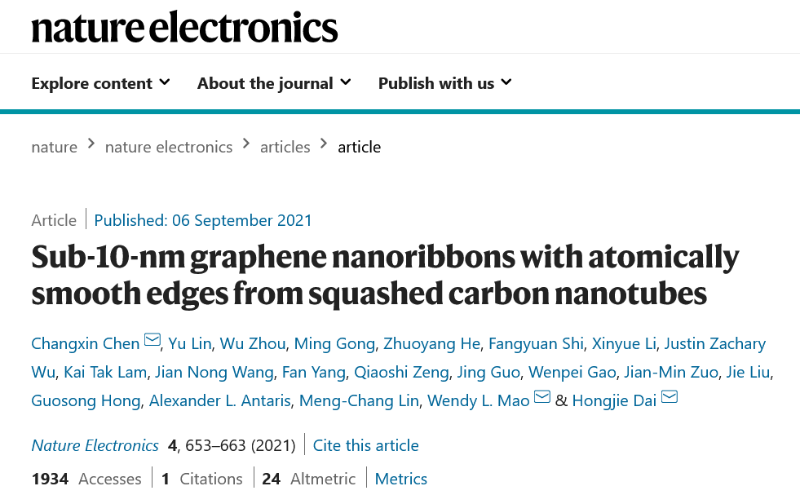

There are two main development routes for field-effect transistors (FETs) in the post-Moore era: One is to further make the silicon devices with smaller line width by improving the fabrication process and technology, the other is to explore new advanced materials for constructing FETs to improve transistor performance as well as reduce device size and power consumption. Traditional silicon-based transistors are subjected to major limitations in terms of theory and technology as the device size continues to decrease. Graphene is a potential transistor candidate or supplementary material due to its atomic layer thickness and ultra-high carrier mobility. However, two-dimensional graphene is a semi-metal material and has no band gap, so it cannot be used directly to realize the on/off characteristics of transistors. An effective way to solve this is to make one-dimensional graphene nanoribbons (GNRs), which can make the bandgap of graphene opened by the quantum confinement effect and edge effect. Studies have found that when their widths are narrower than 10 nm, GNRs are all-semiconducting. Especially, when their widths are less than 5 nm, GNRs will have a sizeable bandgap value to meet the requirement of the applications in transistors and integrated circuits. However, it is still a great challenge to prepare narrow and long GNRs with smooth edges, large bandgaps, and high mobilities.
To solve that problem, the research groups of Prof. Changxin Chen from Shanghai Jiao Tong University, Prof. Hongjie Dai from Stanford University and Prof. Wendy L. Mao from SLAC National Accelerator Laboratory have jointly developed a method to produce sub-10-nm-wide semiconducting GNRs with atomically smooth closed edges by squashing carbon nanotubes (CNTs) via a high-pressure and thermal treatment (Figure 1). With this method, sub-5-nm GNRs with a GNR as narrow as 1.4 nm can be prepared (Figure 2). 54% of single-wall and double-wall CNTs in the sample can be converted into GNRs with closed edges. The nanoribbons are formed under the combined effect of high-pressure treatment and heat treatment. After treatment, the CNTs undergo significant deformation in the radial direction, thereby the closed-edge GNRs are formed. Utilizing the carbon atoms at the edges of squashed CNTs have higher reaction activity than those in the flat center region of CNTs, the researchers also used nitric acid as an oxidant to selectively etch the flattened CNT under high pressure for preparing edge-opened GNRs. The researchers fabricated FETs using GNRs with a width of 2.8 nm. The on/off current ratio of the device can be higher than 104, and the field-effect mobility and on-state conductivity can reach 2443 cm2 V-1 s-1 and 7.42 mS, respectively. The bandgap of the prepared nanoribbons was estimated to be 0.49 eV (Figure 3). The results show that this kind of GNRs have good application prospect in logic circuits.
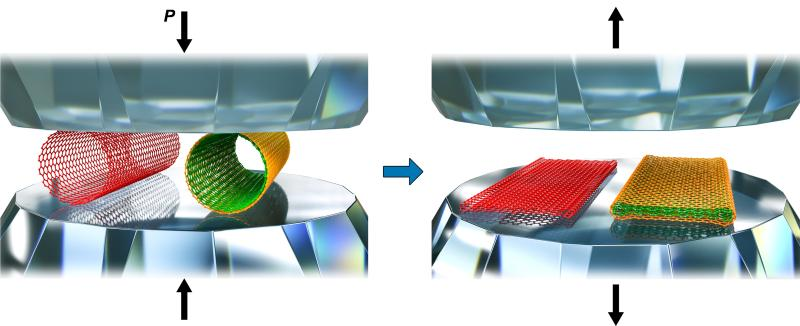
Figure 1. Schematic of squashing an SWCNT and DWCNT (left) into edge-closed double-layer and four-layer GNRs (right) via a high-pressure (P) and thermal treatment. (source: Nature Electronics)
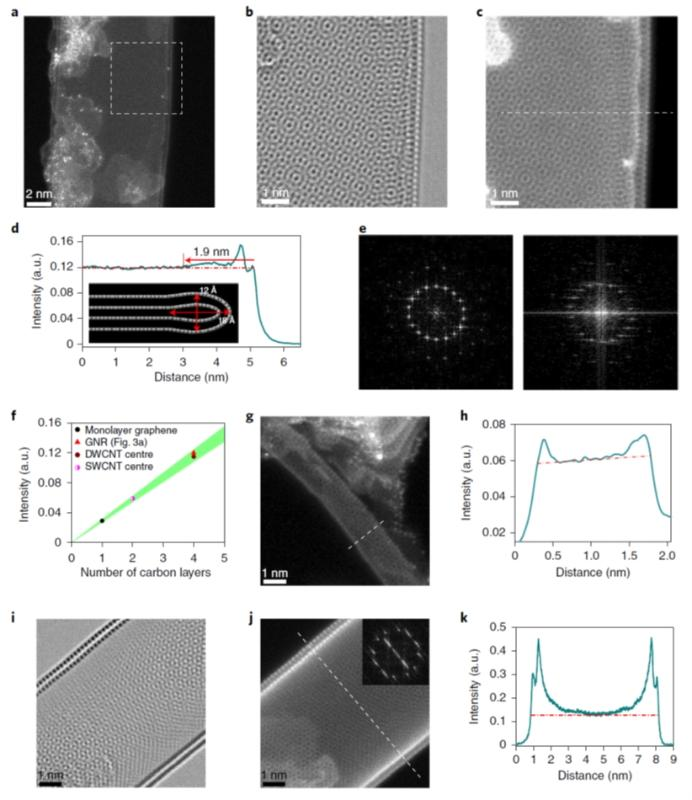
Figure 2. High-resolution STEM characterization of GNRs in treated Samples and a DWCNT. (source: Nature Electronics)
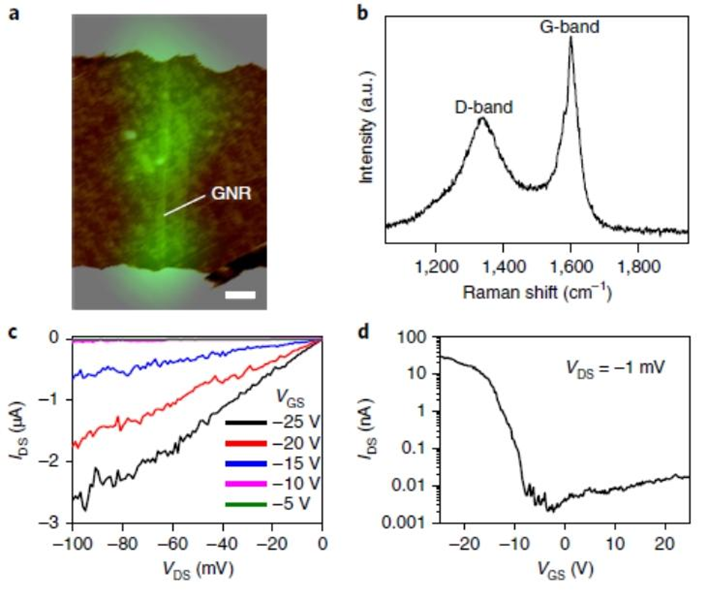
Figure 3. Room-temperature electrical measurements of an edge-closed GNR from a squashed DWCNT. (source: Nature Electronics)
This work provides a route to fabricate narrow and long GNRs with smooth edges, sizeable bandgaps and high mobilities, and also provides guidance for controlling the edge types for exploring their fundamental properties and practical application in electronics and optoelectronics. The method could be extended to other fullerenes and materials that form nanotubes.
This research work was positively appraised by Prof. Chee-Tat Toh at the National University of Singapore in the journal Nature Electronics with the title "Squashing carbon nanotubes into nanoribbons". It has also been featured in many scientific and technological journals and media such as Physics World, Phys.org, Tech Xplore, and Newsbreak.
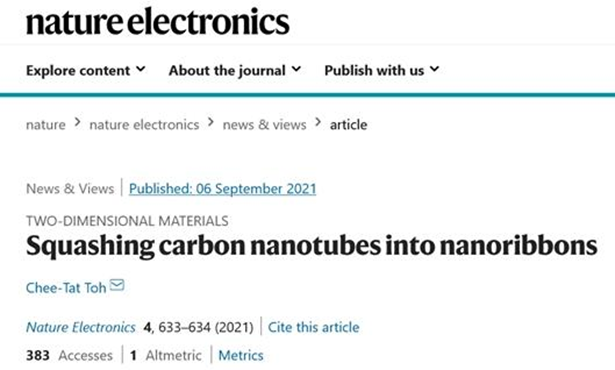
Figure 4. Peer appraisal of this work
Shanghai Jiao Tong University is the first affiliation of this work. Prof. Changxin Chen is the first author and corresponding author of this article, while Prof. Wendy L. Mao and Prof. Hongjie Dai are the co-corresponding authors of this article. This work was supported by the Chang Jiang (Cheung Kong) Scholars Program of Ministry of Education of China (no. Q2017081), National Natural Science Foundation of China for Excellent Young Scholars (no. 61622404), National Natural Science Foundation of China (no. 62074098) and Science and Technology Innovation Action Program from the Science and Technology Commission of Shanghai Municipality (no.15520720200).
Paper link: https://www.nature.com/articles/s41928-021-00633-6
Peer appraisal in the journal Nature Electronics: https://www.nature.com/articles/s41928-021-00645-2
-
Students
-
Faculty/Staff
-
Alumni
-
Vistors
-
Quick Links
